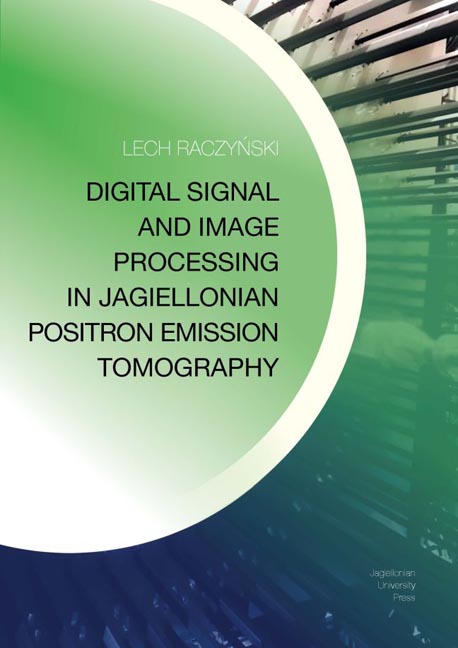Book contents
- Frontmatter
- Dedication
- Acknowledgements
- Contents
- Abbreviations
- Preface
- 1 Introduction
- 2 Positron Emission Tomography
- 3 Algorithmic background
- 4 Low-level data processing in Jagiellonian PET
- 5 High-level data processing in Jagiellonian PET
- 6 Results
- 7 Conclusions and summary
- Appendix
- References
- Miscellaneous Endmatter
3 - Algorithmic background
Published online by Cambridge University Press: 13 October 2023
- Frontmatter
- Dedication
- Acknowledgements
- Contents
- Abbreviations
- Preface
- 1 Introduction
- 2 Positron Emission Tomography
- 3 Algorithmic background
- 4 Low-level data processing in Jagiellonian PET
- 5 High-level data processing in Jagiellonian PET
- 6 Results
- 7 Conclusions and summary
- Appendix
- References
- Miscellaneous Endmatter
Summary
This chapter presents methods that constitute the theoretical background for digital signal and image processing proposed in this work. The algorithms described on the following pages are essential for formulation and solution of subsequent steps of signal and image processing in the J-PET detector. For clarity of the presentation, state-of-the-art data processing methods are presented separately. Details of the applications and modifications of algorithms described in this part will be introduced in chapters 4 and 5.
The methods described in this chapter are applied to different type of data, depending on the stage of data processing. Despite the fact that the details of the signal and image processing in the J-PET scanner will be explained and discussed in chapters 4 and 5, at this point I would like to underline a few important aspects. First of all, it should be stressed that Compressive Sensing (CS) theory is the key method in the proposed signal recovery scheme. The idea of the CS approach will be introduced in section 3.1. Moreover, one of the most important aspect of the proposed image reconstruction is the application of Total Variation (TV) regularization. The concept of the TV regularization will be discussed in section 3.2. Finally, the visualization of the feature space of the information acquired by the J-PET scanner is provided by using the Self-Organizing Maps (SOMs). The short introduction to unsupervised learning algorithms will be given in section 3.3.
Compressive Sensing
The CS [52, 53] is a signal processing method that exploits the sparsity of a signal to recover it from far fewer samples than required by the Nyquist–Shannon sampling theorem. Consider the recovery of a finite signal y0 ∊ ℝN in a situation where the number M of available samples, denoted as measurement y Ω ℝM, is much smaller than the signal dimension N (yΩ is sampled on some partial subset , where the cardinality Ω = M). In the CS method, a sparse expansion x0 ∊ ℝN of signal y0, evaluated via linear and orthonormal transformation y0 = Ax0, is considered. In the following we assume that we are given a contaminated measurement y and hence:
where AΩ is a M ×N matrix modeling the sampling system, constructed from M rows of matrix A that corresponds to the indexes of y described in the subset Ω, and e is an error term.
- Type
- Chapter
- Information
- Publisher: Jagiellonian University PressPrint publication year: 2021



